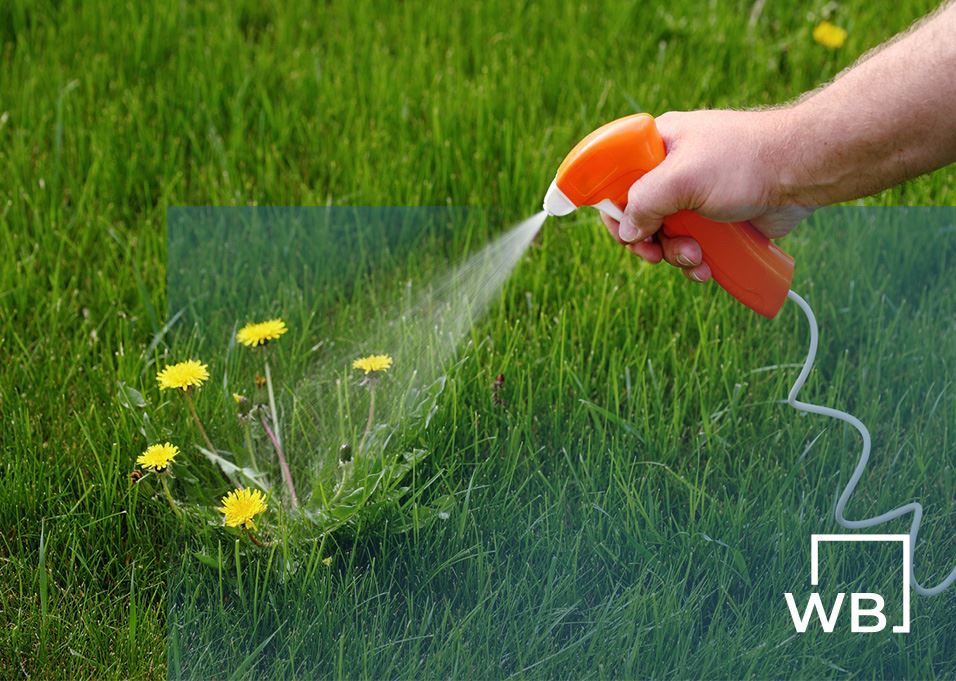
-
National Reach & Recognition Our team was the only attorneys in America to serve on the trial teams for all three of the first Monsanto Trials
-
Experienced Legal Counsel
The Wisner Baum attorneys obtained a $2 billion jury verdict in Pilliod et. al v. Monsanto Co., the ninth largest personal injury verdict in U.S. history.
-
Proven Track Record We have helped negotiate $10.9 billion in Monsanto Roundup settlements on behalf of clients nationwide.
Monsanto Roundup Lawsuit
Roundup Lawsuit Update - May 2025
The attorneys at Wisner Baum are no longer accepting Roundup cases.
Roundup (glyphosate) weed killer is listed as a probable human carcinogen by the International Agency for Research on Cancer (IARC), an arm of the World Health Organization (WHO). Thousands of people who used Roundup or other glyphosate-based herbicides and developed non-Hodgkin lymphoma have filed Roundup cancer lawsuits against Monsanto (now Bayer).
Here is a summary of the Roundup lawsuits, which are ongoing:
- Monsanto/Bayer have faced over 165,000 Roundup lawsuits since the start of litigation.
- Wisner Baum helped negotiate Roundup settlement agreements worth approximately $11 billion, resolving roughly 60% of cases.
- Wisner Baum managing partner R. Brent Wisner was co-lead trial counsel in two of the first three Roundup cancer lawsuits to go before juries. The trials culminated in jury verdicts worth over $2.3 billion.
- Roundup cancer attorneys have obtained roughly $6 billion in combined jury verdicts in 2024 and 2025.
- Bayer estimates that there are over 54,000 pending Roundup lawsuits.


Contact our experienced attorneys to learn about your legal options. Your consultation
is free and confidential.
Roundup Settlement Update
Since the $10.9 billion Roundup settlement in 2020, there have not been any additional reported settlements between plaintiffs and Bayer, though that could change. Trials in the Roundup litigation are ongoing.
ROUNDUP VERDICT Amounts
Since 2018, there have been over two dozen Roundup trials. The majority of cases culminated in wins for Bayer/Monsanto. However, plaintiffs have prevailed in at least 10 trials with jury verdicts in the billions.
2025 ROUNDUP VERDICTS
Barnes v. Monsanto Co.
- Plaintiff: John Barnes
- Verdict: $2.065 billion ($65 million in compensatory damages and
$2 billion in punitive damages)
2024 ROUNDUP VERDICTS
Melissen v. Monsanto Co.
- Plaintiff: William and Margaret Melissen
- Verdict: $78 million ($3 million in compensatory damages and $75 million in punitive damages)
Young v. Monsanto Co.
- Plaintiff: Ryan Young
- Verdict: Monsanto/Bayer Win
Purnell v. Monsanto Co.
- Plaintiff: Debra Purnell
- Verdict: Case discontinued by plaintiff
Kline v. Monsanto Co.
- Plaintiff: Carl Kline
- Verdict: Monsanto/Bayer Win
Cloud v. Monsanto Co.
- Plaintiff: Family of Anthony Cloud (wrongful death)
- Verdict: Mistrial
Cody v. Monsanto Co.
- Plaintiff: Family of Wanda Cody (wrongful death)
- Verdict: Monsanto/Bayer Win
McKivison v. Monsanto Co.
- Plaintiff: John McKivison
- Verdict: $2.25 billion ($250 million in compensatory damages and $2 billion in punitive damages), later reduced to $400 million on appeal2023 ROUNDUP VERDICTS
Jones v. Monsanto Co.
- Plaintiff: Bruce Jones
- Verdict: Monsanto/Bayer Win
Martel v. Monsanto Co.
- Plaintiff: Kelly Jo Martel
- Verdict: $3.5 million ($462,500 in compensatory damages and $3 million in punitive damages)
Anderson et. al v. Monsanto Co.
- Plaintiffs: Daniel Anderson, Jimmy Draeger, and Valorie Gunther
- Verdict: $1.56 billion total (61 million in compensatory damages and $1.5 billion in punitive damages)
– Anderson: $538 million ($38 million compensatory + $500 million punitive)
– Draeger: $517.5 million ($17.5 million compensatory + $500 million punitive)
– Gunther: $505.6 million ($5.6 million compensatory + $500 million punitive)
Dennis v. Monsanto Co.
- Plaintiff: Michael “Mike” Dennis
- Verdict: $332 million ($7 million in compensatory damages and $325 million in punitive damages), later reduced to $28 million
Caranci v. Monsanto Co.
- Plaintiffs: Ernest Caranci and his wife Carmela Caranci
- Verdict: $175 million ($25 million in compensatory damages and $150 million in punitive damages)
Durnell v. Monsanto Co.
- Plaintiff: John L. Durnell
- Verdict: $1.25 million in compensatory damages upheld on appeal in 2025
McCostlin v. Monsanto Co.
- Plaintiff: Mark McCostlin
- Verdict: Monsanto/Bayer Win
Gordon v. Monsanto Co.
- Plaintiff: Sharlean Gordon
- Verdict: Monsanto/Bayer Win

The Only Attorneys in America to Serve on the Trial Teams for the First Three Roundup Trials
The first three Roundup lawsuits to proceed to trial resulted in a combined $2.424 billion in jury verdicts. Wisner Baum is the only law firm in the country to serve on the trial teams for all three of the first Monsanto lawsuits to go before juries. In two of the first three trials, Wisner Baum managing partner R. Brent Wisner served as co-lead trial counsel.

-
Pilliod et al. v. Monsanto Co. $2 Billion Verdict
-
Johnson v. Monsanto Co. $289 Million Verdict
-
Hardeman v. Monsanto Co. $80 Million Verdict
The Roundup lawyers at Wisner Baum have not been involved in the Roundup litigation since the $10.9 billion settlement reached in 2020.
May 9, 2025: The Pennsylvania Superior Court affirmed a $177.3 million judgment awarded to Roundup plaintiff Ernest Caranci and his wife. The three-judge panel rejected all of Monsanto's grounds for appeal, including claims that the verdict was excessive. Most notably, the court rejected Monsanto's argument that the Federal Insecticide, Fungicide and Rodenticide Act (FIFRA) preempted state-law failure to warn claims.
The original verdict came in 2023 after Caranci developed non-Hodgkin's lymphoma following years of Roundup use. The case (Caranci v. Monsanto) included claims of negligence, strict liability for defective design, and failure to warn.
More than 4,400 Roundup lawsuits are pending in the federal MDL. State court litigation continues to drive the overall Roundup litigation landscape, with recent plaintiff verdicts maintaining pressure on Bayer to resolve remaining claims.
Roundup lawyers note that while Bayer has won numerous defense verdicts, the string of significant plaintiff victories like the Caranci case and the massive Georgia verdict a couple of months ago demonstrate the multinational corporation remains vulnerable to court losses as the litigation drags on.
April 30, 2025: Bayer has renewed its efforts to seek Supreme Court review in the Roundup litigation, arguing that federal law preempts state failure-to-warn claims because the EPA doesn't require a cancer warning label. The Supreme Court previously rejected similar arguments, and legal observers note that the chances of the Court intervening now are slim.
On the legislative front, North Dakota introduced House Bill 1318, which opponents describe as a dangerous, sweeping immunity bill that would block lawsuits brought by individuals alleging harm from pesticides and herbicides. We believe this bill prioritizes corporate interests over public health and consumer protection by preventing people from bringing a case to court when corporations make products that cause harm.
As for upcoming Roundup trials, there are a couple scheduled in May in St. Louis and another multi-plaintiff case scheduled to begin in June in Chicago.
March 24, 2025: A Georgia jury delivered a massive blow to Bayer, ordering the company to pay over $2 billion in damages to John Barnes. Mr. Barnes alleged in his lawsuit that he developed non-Hodgkin's lymphoma after using Roundup.
The jury awarded him $65 million in compensatory damages and $2 billion in punitive damages.
Bayer continues to dispute claims that Roundup causes cancer and has announced plans to appeal the verdict. Despite numerous jury verdicts and its setting aside some $16 billion to settle cases, Bayer continues to “stand fully behind the safety” of its glyphosate-based herbicides.
February 12, 2025: The Roundup MDL before Judge Vince Chhabria in Northern California now has 4,414 pending cases. While new cases continue to be filed in the MDL, there continues to be a notable shift toward state court filings where Roundup cancer attorneys have earned several significant verdicts since 2023.
Roundup Cancer Link
In this series of videos, Wisner Baum attorney, R. Brent Wisner, discusses the link between Roundup and cancer, specifically non-Hodgkin lymphoma. We also feature videos about the tragic case of Jack McCall and other clients who spoke at an important press conference in California, to support the State of California involving its Prop 65 glyphosate cancer warning. You will also see a video of Mr. Wisner delivering the historic closing argument in the first Roundup cancer case to be tried against Monsanto.
Brent WisnerRoundup Cancer Attorney
“Monsanto’s history is one full of vast lies. They mislead people, promise that their products are safe and make a lot of money by doing so. And when things get uncomfortable, they simply move on to another product. This strategy has proven successful for over 100 years.” - Brent Wisner
Glyphosate Lawsuit FAQS
If you have questions about your case, don’t hesitate to contact us or call 855-948-5098 to speak with our legal team.
-
What is Glyphosate Weed Killer?
Glyphosate (or N-phosphonomethyl-glycine) is one of the world’s most widely used broad-spectrum herbicides, accounting for roughly 25 percent of the world herbicide market. Glyphosate herbicide is widely utilized in agriculture because it is a cost-effective, easy to use compound that kills weeds, especially annual broadleaf weeds and grasses competing with crops. While it is true that glyphosate products are mostly used in agriculture, some countries also use glyphosate herbicide to control unwanted weed growth in forestry, gardening and in non-cultivated places, like industrial areas and along highways.
-
How Are People Exposed to Glyphosate?
Glyphosate herbicide exposure is most common among farm workers and those living near farmland. Exposure to glyphosate herbicide can happen in a number of ways, including:
- Contact with skin
- Contact with eyes
- Inhaling during usage
- Swallowing (if you have not properly washed your hands after usage)
-
What is the Roundup Lawsuit About?
Roundup (glyphosate) is a Monsanto herbicide used by farmers, gardeners, maintenance workers, agricultural workers, and many others as an all-purpose weed killer. Since Roundup first entered the market in the 1970s, Monsanto has denied claims that Roundup causes cancer, insisting that Roundup is safe. A Monsanto advertisement once noted that Roundup is “safer than table salt.”
But according to internal Monsanto emails now known throughout the world as The Monsanto Papers, Monsanto has known for several decades that Roundup (glyphosate) causes cancer. Rather than informing consumers about the glyphosate cancer risk, Monsanto buried the risks as sales of Roundup continued to skyrocket.
In March of 2015, IARC surveyed the published research on Roundup cancer links and concluded the blockbuster herbicide is “probably carcinogenic to humans.” The cancer agency further concluded that the cancer most associated with exposure to glyphosate is non-Hodgkin lymphoma.
Outraged by Monsanto’s deception, more than 100,000 people have made the decision to file a Roundup lawsuit alleging exposure to Roundup causes cancer.
Our firm represents thousands of people who are pursuing justice against Monsanto (now Bayer) because they do not want what happened to them or a member of their family to happen to anyone else. They want consumers to have the choice— to know the health consequences associated with using a product. If they would have known that Roundup was a carcinogen, they never would have used the product. -
If I File a Roundup Lawsuit, Am I Joining a Monsanto Class Action?
No, the individual Roundup lawsuits over the link to non-Hodgkin lymphoma are not part of a Monsanto class action. The individual Roundup cancer lawsuits seek remedy for injuries (non-Hodgkin lymphoma) sustained as a result of being exposed to Roundup and its active ingredient, glyphosate.
Roundup class actions against Monsanto are related to allegations of false and misleading information on the Roundup label and don’t involve personal injury or wrongful death claims. According to the class actions, Monsanto continues to mislead consumers by representing glyphosate, the active ingredient in Roundup, as targeting an enzyme that is “found in plants but not in people or pets.”
The Monsanto class actions (filed in multiple states) allege that the enzyme glyphosate targets exist in people and pets. Per the class actions:
“Glyphosate functions as a biocide by inhibiting the enzyme 5-enolpyruvylshikimate-3-phosphate (“EPSP”) synthase, disrupting the fifth of six enzymatic steps in the shikimate pathway, which processes aromatic amino acids in certain organisms. Although humans and other mammals themselves do not have a shikimate pathway, the shikimate pathway is present in bacteria, including beneficial bacteria that inhabit the mammalian gut and are essential to overall health. EPSP is therefore “found in . . . people [and] pets. Just like it inhibits EPSP synthase in weeds, the active ingredient in Roundup inhibits EPSP synthase in these human and pet gut bacteria, and just like it targets weeds, the active ingredient in Roundup targets the human and pet gut bacteria.”
-
What is the Difference Between an Individual Roundup Lawsuit and the Roundup Class Action?
Individual lawsuits against Monsanto seek remedy for personal injuries (non-Hodgkin lymphoma) sustained as a result of exposure to Roundup. Farmers, farm workers, horticulturalists, landscapers, gardeners, government employees, and a host of other people have filed individual lawsuits against Monsanto based on allegations that Monsanto knew about the link between exposure to Roundup and non-Hodgkin lymphoma, but failed to warn consumers.
The Monsanto Roundup class action, on the other hand, involves consumers who say they would never have purchased Roundup products had they known that glyphosate targets an enzyme that exists in the human body and the bodies of certain mammals, contrary to Monsanto’s marketing.
Anyone who purchased certain Roundup products and are not participating in a personal injury or wrongful death lawsuit can participate in the Monsanto class action over the misbranding of Roundup. Claimants are not required to prove that they suffered personal injuries as a result of using the product, only that they purchased the product.
Wisner Baumare not only amazing attorneys, but more importantly they are activists. They are about changing the systems which got us into trouble in the first place. They understand their role in the process of making change. Attorneys have the fortunate ability to go into the company files during the investigative process. They see the companies’ behaviors and work hard at getting confidential documents declassified that have true public health benefit. — Kim Witczak.
-
Does Roundup Cause Non-Hodgkin Lymphoma?
Yes. According to numerous studies, exposure to Roundup increases the risk of developing non-Hodgkin lymphoma. Below are some of the studies demonstrating the link between Roundup exposure and NHL:
- Genotoxic activity of glyphosate and its technical formulation Roundup
- Systematic review and meta-analysis of glyphosate exposure and risk of lymphohematopoietic cancers
- Integrative assessment of multiple pesticides as risk factors for non-Hodgkin lymphoma among men
- Exposure to pesticides as risk factor for non-Hodgkin lymphoma and hairy cell leukemia: pooled analysis of two Swedish case-control studies
- Non-Hodgkin lymphoma and specific pesticide exposures in men: cross-Canada study of pesticides and health
- Non-Hodgkin lymphoma and occupational exposure to agricultural pesticide chemical groups and active ingredients: a systematic review and meta-analysis
-
How Does Glyphosate Cause Cancer?
Studies show that exposure to Roundup and its active ingredient, glyphosate, can cause DNA damage and DNA strand breaks, an important precursor to cancer. IARC specifically assessed the genotoxicity of Roundup (the property of chemical agents that damages the genetic information within a cell causing mutations, which may lead to cancer) and concluded that “[t]here is strong evidence that glyphosate causes genotoxicity.”
Roundup exposure can also induce oxidative stress, which is thought to be involved in the development of numerous conditions, including cancer, autism, and Parkinson’s disease. In addition to DNA damage and oxidative stress, some scientists have suggested Roundup exposure can lead to a chronic inflammatory state in the gut, as well an impaired gut barrier, which can increase the risk of cancer.
-
 Suboxone Lawsuit Update: Latest News in Tooth Decay Litigation – July 2025
Suboxone Lawsuit Update: Latest News in Tooth Decay Litigation – July 2025 -
 European Regulators Confirm Ozempic Vision Loss Risk
European Regulators Confirm Ozempic Vision Loss Risk -
 Sprout Baby Food Lawsuit 2025 – What Parents Should Know
Sprout Baby Food Lawsuit 2025 – What Parents Should Know -
 Murphy Canyon Plane Crash Lawsuit: Potential Legal Claims for Families
Murphy Canyon Plane Crash Lawsuit: Potential Legal Claims for Families -
 Publix Baby Food Recall 2025: GreenWise Pouches May Contain Lead
Publix Baby Food Recall 2025: GreenWise Pouches May Contain Lead -
 Report: Baby Food Companies Fail to Meet California Lead Standards
Report: Baby Food Companies Fail to Meet California Lead Standards -
 Depo-Provera Lawsuit Eligibility Guide 2025
Depo-Provera Lawsuit Eligibility Guide 2025 -
 Wisner Baum Files Lawsuit Alleging J&J and Eli Lilly Concealed Antipsychotic Breast Cancer Risks
Wisner Baum Files Lawsuit Alleging J&J and Eli Lilly Concealed Antipsychotic Breast Cancer Risks
Glyphosate Side Effects
Scientists have been able to correlate a number of health issues related to glyphosate exposure, including, but not limited to:
- ADHD: The journal Environmental Health Perspectives reported in 2002 that exposure to Roundup [glyphosate herbicide] was linked to attention deficit disorder (ADHD), likely due to the herbicide’s capacity to disrupt thyroid hormone functions.
- Alzheimer’s Disease: A study published in the journal Toxicology found that glyphosate exposure can cause the same kind of oxidative stress and neural cell death found in Alzheimer’s diagnosis. It also affects CaMKII, an enzyme whose dysregulation has also been linked to Alzheimer’s.
- Autism: A research scientist at MIT says exposure to glyphosate has a number of biological effects that align with known pathologies associated with autism. One of the parallels is gut dysbiosis among children with autism and glyphosate’s suppression of pathogenic bacteria. Glyphosate also promotes the accumulation of aluminum in the brain. Aluminum is a neurotoxin and the established cause of dialysis dementia.
- Birth Defects: Glyphosate exposure can disrupt the Vitamin A signaling pathway, which is critical for normal fetal development. A study from Paraguay found that babies born to women living less than a mile from fields sprayed with glyphosate herbicide were more than twice as likely to develop birth defects.



.2506051405197.jpg)




